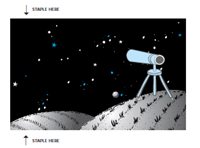Make A Flipbook

Description: Students will learn about persistence of vision by making a flipbook or motion toy
Purpose: To demonstrate the role of persistence of vision in animation
Length of Activity: 40 minutes; this activity can be split between two days. Note that it may be helpful for the instructor to make a flipbook ahead of time to demonstrate for students.
Materials:
- Approximately 20, 3 x 4 inch pieces of paper per student
- Scissors
- Stapler
- Crayons, markers, colored pencils
Steps:
1. Demonstrate a finished flipbook so students will understand how it works. Discuss persistence of vision.
2. Provide each student with about 20 sheets of pre-cut paper. Explain that they will use these to make their own flipbook. To do that they'll have to draw a series of pictures, each slightly different from the next. It might be helpful to brainstorm ideas like a bouncing ball, stick figures doing jumping jacks, or a person opening and closing their eyes.
3. Have students layout their sheets in order and draw one picture on each that is only slightly different from the one before it. Remind them to draw on the right hand side of the paper because the sheets will be stapeled on the left margin.
4. Have students gather their sheets in order and hold their flipbooks in their left hands. As they use the flipbooks, are their animations progressing smoothly? If not, perhaps adding or subtracting a sheet will help? Have them experiment with what's needed to make their flipbooks.
5. When satisfied, students should staple their pages together at the left margin.
6. Have the students share their flipbooks. What makes an animation successful? How does persistence of vision help?
What’s Going On?
When things move very quickly in front of our eyes, it's difficult for the brain to keep each picture separate. Your brain actually continues to see one picture for a very brief moment even after the page has flipped by. This is called persistence of vision. Movies and cartoons work the same way as a flipbook. A movie projector flashes one still picture after another very quickly onto the screen. Your brain blends one picture into the next one, giving you the illusion of movement.